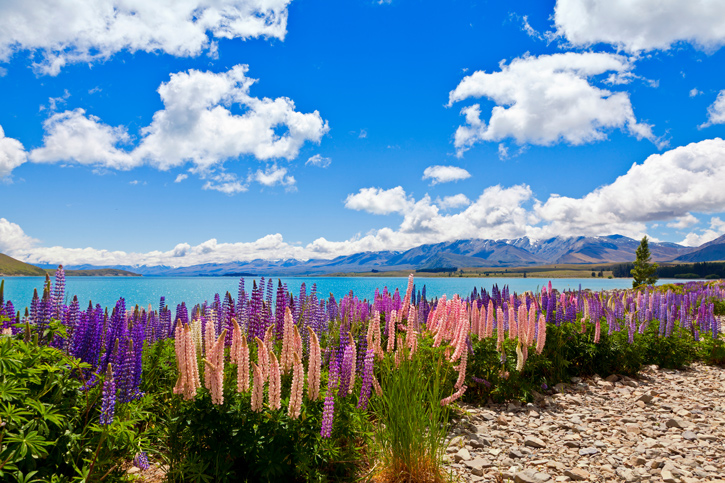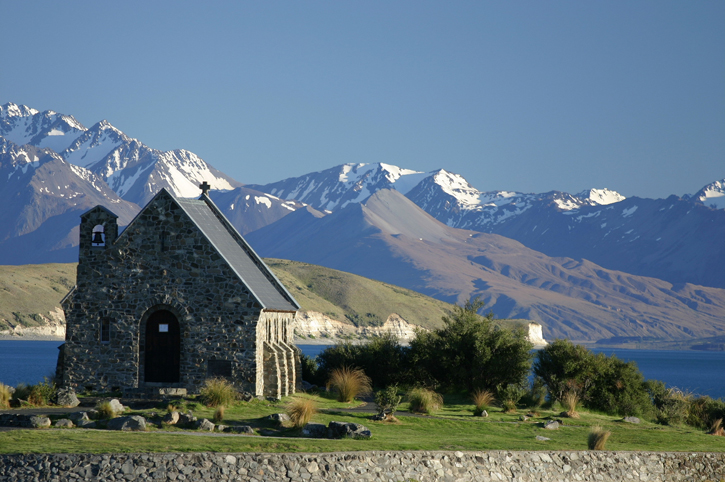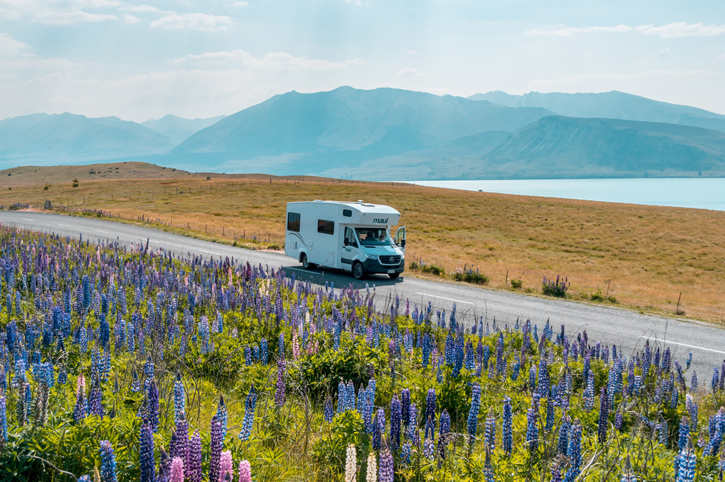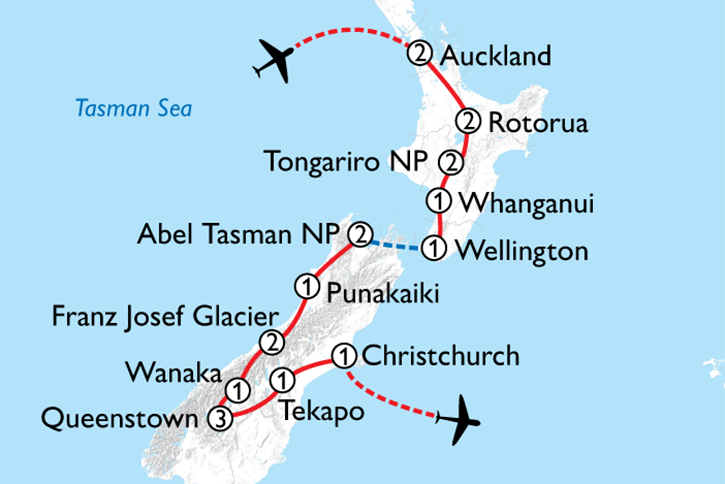
Whilst we’d all love a leisurely six months to explore the stunning mountain and coastal landscapes of New Zealand, if you only have a fortnight in NZ, how do you make the most of your time?
With so much to see and do, there are some tough decisions to be made on what makes it into your two week New Zealand itinerary, and what goes on the list for next time.
Richard, our well-travelled author, can hopefully help…
If you only have 2 weeks available to explore New Zealand, then you will need to plan well and use your time wisely. You will also probably want to get some suggestions from those with experience or a travel professional to get those unique suggestions that you may otherwise miss. With that in mind here is a possible 2 week itinerary in New Zealand that ticks a lot of boxes and certainly shows you the highlights of New Zealand.

You could choose to join an escorted tour of New Zealand. This will do a lot of the planning for you as you will be following a set itinerary and you will have a guide to explain things for you. There are several great options that you can choose from; You can even choose a business class tour if you are not used to group touring.
A motorhome or campervan, is a great option for touring New Zealand, particularly if you are on a budget. However, for this example we are choosing a self drive holiday in New Zealand to enable us to be a little more flexible in where we stop and for how long.
Not surprisingly most New Zealand itineraries start in Auckland. It may not be the capital, but it is certainly the best-connected city in New Zealand. Auckland’s Sky Tower provides panoramic views across the city and is a good starting point to understand the geography. A relatively compact city, Auckland is sandwiched between two large inlets, making it a harbour town with a rich maritime history, giving it the nickname of the “City of Sails”.
Auckland is a melting pot of international cultures, with Asian, Pacific Island and European influences. This is reflected in the cuisine and the harbour front is a great place for alfresco dining.
You get a different view of Auckland from on the water, so don’t miss the opportunity to jump on the ferry to Waiheke Island. Not only will you get a change of scenery, but it will give you the opportunity to visit some of the best local vineyards that are based on the island. If wine is not your thing, then the island is home to plenty of walking trails that enable you to explore some of the inlets and beaches around the island before you return to the city.
Your first decision is which direction to head from Auckland. Quite correctly, many people will point to the beauty of the Bay of Islands to the north, but to keep to a two week timetable, you will probably need to sacrifice the northern tip of the North Island and instead head to the Coromandel Peninsula.
This stunning part of New Zealand’s coastline is just a 90-minute drive from Auckland and yet feels a world away from the city. With a mountainous interior covered in native rainforest and around 250 miles of golden sandy beaches, The Coromandel Peninsula feels quite rustic and undeveloped.

Near to the town of Hahei, is the jewel in the Coromandel’s crown, Cathedral Cove. Reached by a coastal footpath through the Pohutukawa trees, or commonly by kayak or boat, this natural rock arch is one of New Zealand’s most photographed natural structures. The Cathedral Cove rock arch connects two secluded bays and creates a vast cavern through the white rock. Not surprisingly, it has been the location of filming for various movies and music videos. Beyond the beautiful beach area, the neighbouring islands, and the calm seas around them are now designated a protected marine park and are teaming with marine life.
Elsewhere on the Coromandel Peninsula, a visit to the geothermal pools at Whitianga, will reward you with a dip in the therapeutic mineral pools surrounded by native plants and trees. For a price you can even have drinks or a meal delivered to you, whilst you luxuriate in the regenerative waters.
Alternatively, you could board New Zealand’s only mountain railway at Driving Creek. This scenic funicular will take you through native forest, across ten bridges and through three tunnels to a viewpoint at the top of the mountain. On the way you can learn about the mining history of the area and how pottery and conservation efforts are now crucial to the area.
The other-worldly landscapes of Rotorua are a must-see of New Zealand’s North Island. As well as a thriving town, Rotorua is home to 18 different lakes, a depth of Maori heritage and most famously a network of geothermal parks that scent the air with Sulphur.
The lakes and rivers of Rotorua provide several opportunities for exploration. You can select your transport of choice from calm paddle-boarding to a speeding jet boat, you can kayak across the lake to witness glow worms at night or get your adrenaline kicks from white-water rafting. The choice is yours.
Rotorua is probably the best place to experience the traditional practices and customs of the indigenous Maori people. Authentic performances and cultural tours provide a special insight into the practices, beliefs and traditions of Maoris both past and present. Whether you want to understand how to perform the haka or learn how to cook in a traditional hangi underground oven, then Rotorua is the destinations to do it.
Maori culture is strong in Rotorua because they learnt to use the natural resources. It is something that continues today as the town is a centre of geothermal energy. During your time in Rotorua, it is important that you visit some of the geothermal parks in the area to witness bubbling mud pools, steaming vents and spouting geysers. Each park gives a different perspective on what is occurring beneath our feet and the colourful sinter terraces that are visible around much of the town are a reminder of what happens when that energy reaches the surface. Kuira park in the town’s centre, Hell’s Gate geothermal reserve and Waikite thermal pools are amongst the best.
New Zealand holidays by Freedom Destinations.


Auckland | Rotorua | Napier | Wellington | Franz Josef | Wanaka | Queenstown | Christchurch


Auckland | Bay of Islands | Wellington | Nelson | Franz Josef | Queenstown | Christchurch


Auckland | Rotorua | Tongariro | Wellington | Abel Tasman | Punakaiki | Queenstown | Tekapo | Christchurch


Auckland | Rotorua | Napier | Wellington | Franz Josef | Wanaka | Queenstown | Christchurch


Auckland | Bay of Islands | Wellington | Nelson | Franz Josef | Queenstown | Christchurch


Auckland | Rotorua | Tongariro | Wellington | Abel Tasman | Punakaiki | Queenstown | Tekapo | Christchurch
On leaving Rotorua you face another decision; whether to head across to Tongariro National Park or to stick with the east coast on your route south. If you are a passionate hiker then the Tongariro Crossing is probably the most famous walking trail on the North Island, and the landscapes of the National Park will inspire images of Mount Doom for all Lord of the Rings fans.
However, by turning east you will find your way to the beautiful Hawke’s Bay and round to the city of Napier. Napier is home to one of the most complete collections of Art Deco style buildings in the world. Rebuilt after a devastating earthquake that destroyed much of the city centre in 1931, the predominant style of the time now dominates streets in the centre.
The natural geography of Napier and the Hawke’s Bay area makes it the perfect location for vineyards and the wine industry that have made this area home. There are plenty of restaurants and bars around Napier here you can sample the local product, but to get a fuller understanding of why this area has become the wine capital of New Zealand then taking a tour of one of the vineyards is a must. Even if you are no wine expert, the scenery is worth the visit alone.
From Hawke’s Bay it is a straight run to reach the southernmost point of the North Island, and the country’s capital Wellington. Situated on the Cook Straight between the two islands, Wellington can feel a bit like a natural wind tunnel, but it is also a compact capital, and relatively easy to explore.

A great way to understand the geography of Wellington is catch the funicular railway (cable-car) from the centre of the Lambton Quay shopping area up to Kelburn Hills. There are only four stops along the route up the hillside, and the journey only takes five minutes, but the panoramic view from the top is well worth the journey. Once you have taken in the view then you may also enjoy a wander around the cable car museum, telling the history of Wellington’s unique red train, or walk on further to explore the Botanic Gardens.
It is difficult to ignore the impact that Hollywood has made on the New Zealand economy, and Wellington is no exception. Wellington became the hub of New Zealand’s movie making industry, riding the wave of Peter Jackson’s Lord of the Rings trilogy. The film studios and workshops of Weta have since gone on to be involved in other films such as Avatar, King Kong and The Avengers series. It is possible to learn more about the movie industry with a behind the scenes tour of the Weta Workshop, where you can learn the processes involved, how technology has developed and enjoy some of the costumes and collectibles that are now housed in Wellington.
More than just a simple ferry journey, the crossing of the Cook Straight between New Zealand’s North and South Islands, is actually one of the most beautiful sailings in the world. Catching either the Bluebridge or Interislander ferry, the sailing makes its way from the urban centre of Wellington, out past the rugged cliffs of the Wellington Heads. Once beyond the headlands, on a clear day it is already possible to see the South Island in the distance.

As you approach the South Island, the ship will gradually navigate through the Tory Channel, passing the Queen Charlotte Sounds, with clear waters lapping up to native forest on both sides. There is usually a good opportunity to spot some native New Zealand sea life on the journey across the Cook Straight. Between June and September large numbers of humpback whales migrate through the Cook Strait, whilst at other times it is possible to spot other whales, orca, dolphins and fur seals amongst the waves. Looking upwards, as well as the usual gulls and guillemots, it is also sometimes possible to spot an albatross gliding above the ferry. It really is a feast for nature lovers.
You will arrive on to New Zealand’s South Island, via the Marlborough Sounds. The Marlborough Sounds encompass around 1000 miles of mostly untouched coastline, including forests, beaches and sheltered bays. The ferry will dock at the base of one of the bays, in the town of Picton. An attractive town, Picton has several seafront cafés and restaurants as well as art galleries and craft shops.
From Picton you will have another choice. You could choose to make your way to the east coast and make your way south via Kaikoura to Christchurch, but whilst this is a good route for whale watching along the coast, it would miss out a lot of the unique scenery of the South Island. Instead turning right out of Picton will take you towards the west coast, with the first stop at Nelson.
The town of Nelson is the main hub of the Tasman Nelson Region. It is home to many artists and is the capital of New Zealand’s craft brewing industry. It is also the gateway to three of New Zealand’s most picturesque National Parks; Kahurangi, Nelson lakes and Abel Tasman. Of these parks the Abel Tasman National Park is probably the most accessible, despite there being no roads. The park is most famous for its coastal walking track that winds across the sandy beaches and across the forested headlands. Although only the fittest will be able to hike the full length of the trail, others can catch a water taxi or kayak with a guide and then use the coastal track to retrace their steps. Keep an eye out for fur seals, penguins and dolphins that frequent the calm waters.

From Nelson, Highway 6 brings you across to the coast at Westport, and then follows the coastline south towards the town of Greymouth. On the route you will pass through the Paparoa National Park, and the village of Punakaiki. It is here that you can stop to view the Pancake Rocks and blowholes that surround them. The Pancake rocks are layers of limestone rocks that have been weathered to form multiple stacks. These otherworldly phenomena are located by the sea, which has carved out caverns below, leading to blowholes and spray at high tides. A short looping walk takes you in between the rocks giving you a close and personal viewpoint as the waves crash through.
Greymouth is the largest town on the South Island’s west coast, and marks the end of the TranzAlpine train route from Christchurch. The area has a history for gold and precious stones, including pounamu (Jade). Some of the old mining sites can be viewed along the Elizabeth Walk, a trail that begins at the popular Rapahoe Beach.
Hokitika is great stopping point, south of Greymouth. A short walk takes you to the turquoise waters of Hokitika Gorge, where there are stunning views of the glacial river as it flows through the native Rimu forest. The village of Hokitika is also the home of the National Kiwi Centre, which offers the opportunity to get up close and personal with New Zealand’s rare national icon.
New Zealand boasts two of the world’s most accessible glaciers along the west coast of the South Island. Just 5 miles from the town of Franz Josef, the Franz Josef Glacier snakes down through the forest towards the sea. Similarly, Fox Glacier, 12 miles south of Franz Josef, is a glacial arm that extends down almost to sea level. Both glaciers are fed from the icefields of the Southern Alps.

Despite the relatively mild temperatures and receding ice, it is still possible to visit both glaciers through guided tours that walk on the ice. To access the Franz Josef Glacier, it is necessary to use a helicopter transfer to a higher part of the glacier as part of a guided tour. Tour companies provide safety briefings, ice-picks and crampons to enable people to walk on the ice. Just the flight to the beginning of the hike is spectacular. Similarly, Fox Glacier suffered from landslides and flooding in recent years, making the lower reaches of the glacier unsafe. So currently it is only possible to hike up to the Fox glacier and view from a distance or use a helicopter to reach stable icefields higher up.
No holiday to New Zealand’s South Island would be complete without a visit to Queenstown. Built on the shores of Lake Wakatipu, Queenstown is surrounded by spectacular mountain views. The aptly named “Remarkables” mountain range loom large in most photographs. Queenstown is at the heart of the South Island in every sense.
Queenstown has become known as the adventure capital of New Zealand and tourists flock to the town for the abundance of outdoor activities that are all available in the natural surroundings. Whilst Queenstown was the birthplace of bungy jumping, it is not just high adrenaline activities that attract the visitors. There are plenty of international restaurants in the centre of town and local vineyards and breweries surround the outskirts.
Lake Wakatipu hosts every water sport thinkable, from paddle boarding to jet boating, or kayaking to fishing. Taking the steamship for a cruise across the lake to a traditional working sheep farm is a great way to introduce yourself to Queenstown’s surroundings, as is the gondola cable-car that offers panoramic views from Bob’s Peak.
The picturesque town of Te Anau is the gateway to the Fiordland National Park, home to some of the most beautiful scenery in the whole of New Zealand. The jewels in the Fiordland crown are Milford Sound and Doubtful Sound. Both are glacial carved fjords, with steep-sided cliffs surrounding calm and clear waters.
Doubtful Sound is inaccessible to road traffic and will take time to visit, but Milford Sound is around a 90 minute drive from Te Anau, along one of the most beautiful roads in the world (Highway 94). It is also possible to hike the Milford Track from Lake Te Anau to Milford Sound during the summer months. Whilst this is a beautiful option for the fittest visitors, it does take four days, and overnight accommodation needs to be pre-booked months, or even years in advance, so this option is for the passionate hikers only.
The road to Milford Sound is stunning, which is just as well, as visitors to Milford Sound are going to see it in both directions. There is no alternative route by vehicle (unless you transfer from Queenstown by helicopter), but this will enable you to stop along the route to explore the reflections in Mirror Lakes, follow the nature walk at Lake Gunn and take a dip in Monkey Creek.

The weather at Milford Sound is at best changeable and more often quite wet. The geography of the area ensures that there is rainfall in Milford Sound more than half of the year, so some form of waterproof is essential. Having said that, rain is essential for some of Milford Sound’s most spectacular attractions, such as 1000 metre waterfalls, so don’t let the rain put you off.
It is possible to hike, rent kayaks and even snorkel and dive in Milford Sound, however, probably the best way to view the fjord and learn more about the area is to join a Milford Sound day cruise out to the ocean and back. It is only by cruising under one of the many waterfalls that you can really appreciate the steep-sided cliffs and the majesty of Milford sound. There are a number of cruise options, including overnight options for those with more time, but all should be pre-booked as it is a long way to travel to find there is no availability. A cruise that includes a stop at the underwater observatory at Harrison Cove will give you the opportunity to view the fjord both above and below the waterline, giving you the chance to observe the marine life of Milford Sound, including rare corals, starfish and anemones.
It is important to dedicate a whole day of your New Zealand itinerary to Milford Sound. The journey to and from Milford Sound from Te Anau and a cruise will definitely fill your day.
It is the best part of 180 miles to drive from Te Anau in the west to Dunedinin the east, but it will feel a world away. Enclosed by the rolling hills of the Otago region, Dunedin is a good example of a preserved Victorian era city, that clings tightly to its Scottish links, complete with its own Scottish castle.
Just 20 minutes from the centre of Dunedin, Lanarch Castle is the only building of its type in New Zealand and was originally built back in 1871 by a rich merchant, proud of his Scottish ancestry. Having been battered by the southern winds, the castle has now been restored and features a large ballroom and fortified tower that offers panoramic views over the Otago Peninsula.
The Otago Peninsula is also home to some unique wildlife that nature lovers will enjoy spotting during their stay in Dunedin. From a short cruise it is possible to view blue and yellow-eyed penguins that share the shoreline with New Zealand fur seals and sealions, whilst just on land it is possible to see the world’s only mainland breeding colony of Northern Royal Albatross.
Sandwiched between The Alps and the ocean, Christchurch is the capital of the Canterbury Region, and is situated roughly midway along the eastern coast of the South Island. Christchurch has also become known as “The Garden City” reflecting the number of well-manicured parks and gardens that surround the city. The city’s Botanic Gardens reflect the ever-changing seasons in Christchurch and the surrounding area.
It is difficult to ignore that the city was devastated by an earthquake in 2011, however the city has bounced back, and the modern city centre now reflects the city’s standing as a centre for arts and culture. A short walk around the centre will reward with murals and other art installations telling the story of Christchurch and what it has achieved following the earthquake, without forgetting those that suffered because of it.

The River Avon that run through Christchurch is a haven for activity in the summer months. Reflecting Christchurch’s status as a university town, it is possible to see the sights from the river on a guided punt, similar to Cambridge in England. This also gives you a local’s view of this resilient city.
For an alternative to the usual museums and outdoor activities that are all available around Christchurch, perhaps take a visit to the International Antarctic Centre. New Zealand’s southerly location makes it ideal to begin scientific exploration of the Antarctic, and Christchurch is often the departure point. The centre not only allows you to learn about the unique wildlife that inhabits Antarctica, it also allows you to get hands on with machinery and equipment used in the scientific bases currently in operation on the ice. To fully appreciate the conditions they are working under, there is even a cold room, that mimics Antarctica’s freezing climate.
Christchurch’s International Airport also marks the end of this two-week itinerary in New Zealand. There is a lot to pack into a short time, but having experienced the highlights on this holiday, you are quite likely to want to return to New Zealand and see more.
“New Zealand is such beautiful and diverse country, that there is never enough time in one trip to fully do it justice” says Matt, one of Freedom Destinations’ New Zealand Travel Consultants. “Of course, I would always like to recommend at least three weeks to enjoy the best of New Zealand, but I understand that holiday time is precious to us all, so two weeks is good for seeing the highlights of New Zealand.”
“When time is limited, it is very important to plan your time, to ensure you see everything that you want to. It will be impossible to experience everything in just one trip, so do some research and decide on your must-see destinations, and then we can plan a route accordingly” continues Matt. “A self-drive holiday in New Zealand does give you the ability to travel independently and create your own itinerary. If you are on a tight budget, I would probably consider renting a motorhome to explore in, and although this itinerary is based on travelling from Auckland, perhaps consider travelling in the opposite direction. It is a less common routing and that can mean some good deals on car rental.”
If this has inspired you to travel to New Zealand on your next holiday, then contact Matt or one of Freedom’s other New Zealand experts to discuss your requirements and begin planning your holiday itinerary.
Richard has more than 25 years of experience working within the travel industry. He has travelled widely in Europe, the USA & Canada, Australia & New Zealand, South East Asia, as well as Southern Africa. He enjoys exploring National Parks and other wilderness areas.